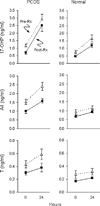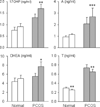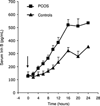Disordered follicle development
- PMID: 22874072
- PMCID: PMC3727408
- DOI: 10.1016/j.mce.2012.07.011
Disordered follicle development
Abstract
Alterations of ovarian follicle morphology and function have been well documented in women with PCOS. These include increased numbers of growing preantral follicles, failure of follicle growth beyond the mid-antral stage, evidence of granulosa call degeneration, and theca cell hyperplasia. Functional abnormalities include paradoxical granulosa cell hyperresponsiveness to FSH which is clinically linked to ovarian hyperstimulation during ovulation induction. In addition, there is likely a primary theca cell defect that accounts for the majority of excess androgen production in this disorder. The precise mechanisms responsible for altered follicle function are not completely clear. However, several factors appear to influence normal advancement of follicle development as well as impair ovarian steroidogenesis. These include intra- as well as extraovarian influences that distort normal ovarian growth and disrupt steroid production by follicle cells.
Published by Elsevier Ireland Ltd.
Figures








Similar articles
-
Interactions between androgens, FSH, anti-Müllerian hormone and estradiol during folliculogenesis in the human normal and polycystic ovary.Hum Reprod Update. 2016 Nov;22(6):709-724. doi: 10.1093/humupd/dmw027. Epub 2016 Aug 27. Hum Reprod Update. 2016. PMID: 27566840 Review.
-
The regulation and signalling of anti-Müllerian hormone in human granulosa cells: relevance to polycystic ovary syndrome.Hum Reprod. 2019 Dec 1;34(12):2467-2479. doi: 10.1093/humrep/dez214. Hum Reprod. 2019. PMID: 31735954
-
Paracrine Regulation of Steroidogenesis in Theca Cells by Granulosa Cells Derived from Mouse Preantral Follicles.Biomed Res Int. 2015;2015:925691. doi: 10.1155/2015/925691. Epub 2015 Aug 19. Biomed Res Int. 2015. PMID: 26357661 Free PMC article.
-
Follicle dynamics and anovulation in polycystic ovary syndrome.Hum Reprod Update. 2008 Jul-Aug;14(4):367-78. doi: 10.1093/humupd/dmn015. Epub 2008 May 22. Hum Reprod Update. 2008. PMID: 18499708 Review.
-
Steroidogenesis in human polycystic ovary.Endocrinol Metab Clin North Am. 1988 Dec;17(4):751-69. Endocrinol Metab Clin North Am. 1988. PMID: 3143567 Review.
Cited by
-
Menstrual Cycle Characteristics in Adolescence and Early Adulthood Are Associated With Risk of Early Natural Menopause.J Clin Endocrinol Metab. 2018 Oct 1;103(10):3909-3918. doi: 10.1210/jc.2018-01110. J Clin Endocrinol Metab. 2018. PMID: 30060103 Free PMC article.
-
Effects of Kelulut Honey on Oestrus Cycle Regulation and Histomorphological Changes in Letrozole-Induced Polycystic Ovary Syndrome Rats: A Preliminary Study.Life (Basel). 2022 Jun 14;12(6):890. doi: 10.3390/life12060890. Life (Basel). 2022. PMID: 35743921 Free PMC article.
-
Granulosa Cells-Related MicroRNAs in Ovarian Diseases: Mechanism, Facts and Perspectives.Reprod Sci. 2024 Dec;31(12):3635-3650. doi: 10.1007/s43032-024-01523-w. Epub 2024 Apr 9. Reprod Sci. 2024. PMID: 38594585 Review.
-
Peroxisome Proliferator-Activated Receptors in Female Reproduction and Fertility.PPAR Res. 2016;2016:4612306. doi: 10.1155/2016/4612306. Epub 2016 Jul 31. PPAR Res. 2016. PMID: 27559343 Free PMC article. Review.
-
MicroRNA-200b and microRNA-200c are up-regulated in PCOS granulosa cell and inhibit KGN cell proliferation via targeting PTEN.Reprod Biol Endocrinol. 2019 Aug 17;17(1):68. doi: 10.1186/s12958-019-0505-8. Reprod Biol Endocrinol. 2019. PMID: 31421682 Free PMC article.
References
-
- Adashi EY, Hsueh AJW. Estrogens augment the stimulation of ovarian aromatase activity by follicle-stimulating hormone in cultured rat granulose cells. J. Biol. Chem. 1982;257:6077–6083. - PubMed
-
- Almahbobi G, Anderiesz C, Hutchinson P, McFarlane JR, Wood C, Trounson AO. Functional integrity of granulosa cells from polycystic ovaries. Clin. Endocrinol. 1996;44:571–580. - PubMed
-
- Barbieri RL, Makris A, Ryan KJ. Insulin stimulates androgen accumulation in incubations of human ovarian stroma and theca. Obstet. Gynecol. 1984;64:73S–80S. - PubMed
-
- Barbieri RL, Makris A, Randall RW, Daniels G, Kistner RW, Ryan KJ. Insulin stimulates androgen accumulation in incubations of ovarian stroma obtained from women with hyperandrogenism. J. Clin. Endocrinol. Metab. 1986;62:904–910. - PubMed
-
- Barnes RB, Rosenfield RL, Burstein S, Ehrmann DA. Pituitary-ovarian responses to nafarelin testing in the polycystic ovary syndrome. N. Engl. J. Med. 1989;320:559–565. - PubMed
Publication types
MeSH terms
Substances
Grants and funding
LinkOut - more resources
Full Text Sources
Other Literature Sources
Medical
Miscellaneous

